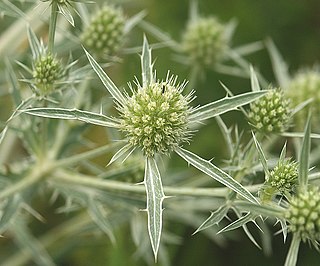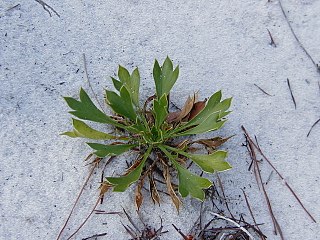
Eryngium is a genus of flowering plants in the family Apiaceae. There are about 250 species. The genus has a cosmopolitan distribution, with the center of diversity in South America. Common names include eryngo and sea holly.
A hardiness zone is a geographic area defined as having a certain average annual minimum temperature, a factor relevant to the survival of many plants. In some systems other statistics are included in the calculations. The original and most widely used system, developed by the United States Department of Agriculture (USDA) as a rough guide for landscaping and gardening, defines 13 zones by long-term average annual extreme minimum temperatures. It has been adapted by and to other countries in various forms.

Eryngium alpinum, the alpine sea holly, alpine eryngo or queen of the Alps, is a herbaceous perennial plant in the family Apiaceae.

Apium is a genus of about 20 species of flowering plants in the family Apiaceae, with a subcosmopolitan distribution in Europe, Asia, Africa, South America and Australia. They are medium to tall biennials or perennials growing up to 1 m high in the wet soil of marshes and salt marshes, and have pinnate to bipinnate leaves and small white flowers in compound umbels. Some species are edible, notably Apium graveolens, which includes the commercially important vegetables celery, celeriac and Chinese celery. Apium bermejoi from the island of Menorca is one of the rarest plants in Europe, with fewer than 100 individuals left.

Eryngium amethystinum, the amethyst eryngo, Italian eryngo or amethyst sea holly, is a clump-forming, perennial, tap-rooted herb. Its stem is 30 to 50 cm long and is light blue to purple in colour. It has a basal circle of obovate, pinnate, spiny, leathery, mid-green leaves. It flowers in mid to late summer with cylindrical umbels, 2–3 cm long atop silvery blue bracts and branching stems. The plant is native to the eastern Mediterranean and prefers dry places and soils that are rich in calcium.

Eryngium campestre, known as field eryngo, or Watling Street thistle, is a species of Eryngium, which is used medicinally. A member of the family Apiaceae, eryngo is a hairless, thorny perennial plant. The leaves are tough and stiff, whitish-green. The basal leaves are long-stalked, pinnate and spiny. The leaves of this plant are mined by the gall fly, Euleia heraclei.

Symphyotrichum ericoides, known as white heath aster, frost aster, or heath aster, is a species of flowering plant in the family Asteraceae native to much of central and eastern North America. It has been introduced to parts of Europe and western Asia.

Eryngium aristulatum, known by the common names California eryngo and Jepson's button celery, is a species of flowering plant in the family Apiaceae.

Eryngium armatum, known by the common names coastal eryngo and prickly coyote thistle, is a species of flowering plant in the family Apiaceae.
Eryngium constancei is a species of flowering plant in the family Apiaceae known by the common name Loch Lomond button celery, or Loch Lomond coyote thistle. It is endemic to California, where it is known from only three occurrences north of the San Francisco Bay Area. One of the populations is at the Loch Lomond Vernal Pool Ecological Reserve at Loch Lomond in Lake County. The plant appears mainly in vernal pools. It is endangered on the state and federal levels.
Eryngium mathiasiae is a species of flowering plant in the family Apiaceae known by the common name Mathias' eryngo, or Mathias' button celery.
Eryngium pinnatisectum is an uncommon species of flowering plant in the family Apiaceae, known by the common names Tuolumne eryngo and Tuolumne button celery.
Eryngium racemosum is a rare species of flowering plant in the family Apiaceae known by the common name delta eryngo, or delta button celery.
Eryngium spinosepalum, known by the common names spinysepal eryngo and spiny-sepaled button celery, is an uncommon species of flowering plant in the family Apiaceae.

Polycarpon is a genus of flowering plants in the family Caryophyllaceae. They are known generally as manyseeds. There are roughly 9 to 15 species, representing most continents. The best-known species is perhaps Polycarpon tetraphyllum, which is native to southern Europe but is present in many other regions as an introduced species. These plants are low, matted annuals spreading slender stems along the ground or erect with many branches.

Eryngium foetidum is a tropical perennial herb in the family Apiaceae. Common names include culantro, recao, chadon beni, Mexican coriander, bandhaniya, long coriander,’’’Burmese coriander’’’,sawtooth coriander, and ngò gai. It is native to Mexico, the Caribbean, and Central and South America, but is cultivated worldwide, mostly in the tropics as a perennial, but sometimes in temperate climates as an annual.

Eryngium cuneifolium is a rare species of flowering plant in the carrot family known by the common names wedgeleaf eryngo, wedge-leaved button-snakeroot, and simply snakeroot. It is endemic to the state of Florida in the United States where it is known only from Highlands County. It is one of many rare species that can be found only on the Lake Wales Ridge, an area of high endemism. It was federally listed as an endangered species of the United States in 1987.

Eryngium aquaticum is a species of flowering plant in the family Apiaceae known by the common name rattlesnakemaster, marsh rattlesnake master, corn-snakeroot, bitter snakeroot, and marsh eryngo. This plant is native to eastern North America.

Eryngium bourgatii, the Mediterranean sea holly, is a species of flowering plant in the family Apiaceae native to Morocco, Lebanon, Turkey, France, and Spain. It is a herbaceous perennial growing to 15–45 cm (6–18 in) tall. The spherical blue flowerheads have spiny bracts.













